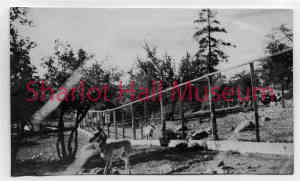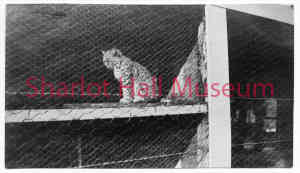By Ricky Erway
In a previous article we were introduced to Frank Murphy, resourceful entrepreneur and generous philanthropist from the time he arrived in Prescott in 1878. This article focuses on a topic that illustrates the two.
 In 1892, he married Ethel Meany and found an enthusiastic partner in philanthropy. Murphy owned 350 acres in the western limits of Prescott. It included what is now Hassayampa Drive, Country Club Drive, around Indian Hill and back over to Coronado Drive, Vista Drive and High Street. Park Avenue led to what he called Murphy Park.
In 1892, he married Ethel Meany and found an enthusiastic partner in philanthropy. Murphy owned 350 acres in the western limits of Prescott. It included what is now Hassayampa Drive, Country Club Drive, around Indian Hill and back over to Coronado Drive, Vista Drive and High Street. Park Avenue led to what he called Murphy Park.
Originally, Murphy Park was planned to be a large housing development with a park, a figure-eight drive (part of which is present-day Country Club Drive), a zoo and a grand residence (which was never built — Murphy donated that land for the Pioneers’ Home).
There was no admission fee to Murphy Park, and for a time, the trolley ran to its entrance. It was popular for walking, horse-drawn travel, and later automobiles. Tent camping was allowed for 50 cents a month.
In many ways, the Murphy Park Zoo was a gift to the community. It was privately developed, maintained at no cost to the city and the public was free to enjoy it. And, in the end, Murphy offered it to the city.
 The entrance to the zoo and the caretaker’s house were on Country Club Drive. The house on the corner of Country Club Drive and Park Avenue was where the birds were located, and it marked the northeast corner of the zoo.
The entrance to the zoo and the caretaker’s house were on Country Club Drive. The house on the corner of Country Club Drive and Park Avenue was where the birds were located, and it marked the northeast corner of the zoo.
Most of the animals were native to Arizona. Zoo residents included: two antelope, two blacktail deer, coyotes, two bobcats, a black eagle, four mountain lions (the only ones in captivity in the US), a badger, two civet cats, four foxes, two porcupines, two peacocks, a raven, two guinea pigs, bears, pheasants, and the “imported” eight monkeys and two baboons.
A. W. Edwards, Murphy’s financial representative, lived in the caretaker’s house and managed the zoo. A resident keeper, Mary Powers Plummer, took care of the animals. Her home had cages and grounds.
The January 11, 1908, Albuquerque Citizen reported that an Indian woman brought a wildcat to the board of supervisors for a bounty, but upon learning it had to be dead first, refused to kill it. A. W. Edwards stepped in and purchased it for $5 and added it to the zoo.
 As Murphy’s health deteriorated, he planned to retire to California. On Christmas Day 1909, he offered 200 acres of Murphy Park, including the zoo, to the city of Prescott. The gift of the land would have resulted in a vast scenic park near the heart of town. Mayor Goldwater and the councilmen were initially enthusiastic, but when faced with the particulars, Mayor Goldwater and the council declined for what the newspaper called “reasons of false economy.”
As Murphy’s health deteriorated, he planned to retire to California. On Christmas Day 1909, he offered 200 acres of Murphy Park, including the zoo, to the city of Prescott. The gift of the land would have resulted in a vast scenic park near the heart of town. Mayor Goldwater and the councilmen were initially enthusiastic, but when faced with the particulars, Mayor Goldwater and the council declined for what the newspaper called “reasons of false economy.”
According to Dewey Born, the city refused the offer because they couldn’t afford to feed the animals (the upkeep was estimated at $75/month, including food and the caretaker’s salary).
In 1912, Murphy‘s offer to present animals to the Arizona Fair to establish a zoo at the Fairgrounds was declined. Ultimately, he gave the animals to the city of Los Angeles (the Griffith Park Zoo opened in 1912). In the process of moving the animals, the bear broke out, went up a tree, and was shot. A history of Griffith Park states that “animals came from the estate of railroad builder Frank Murphy.” The donated animals were two mountain lions, two wildcats, one badger, two civet cats, three foxes, two porcupines and two doe antelope.
The zoo included the 600 and 700 blocks south of Country Club Dr. An account in a 1969 newspaper mentions brick walls in a little valley between Country Club and Copper Basin and the remains of a bear pit on a hill with a cave and pool. It was described as a “huge steel bear cage crown[ing] a pile of boulders” with water pipes, steel hinges and the remains of bars. In 1977, the bear cave with cement pool was reported as still standing on an empty lot. And that was all that was left of the Murphy Park Zoo.
Murphy died in 1917 after having been “crippled by an illness that would shorten his life.” His widow, Ethel, moved to Ontario, California, where he was buried. She declined to erect a monument in Prescott to honor Murphy, preferring to let his accomplishments stand alone as testament to the man.
“Days Past” is a collaborative project of the Sharlot Hall Museum and the Prescott Corral of Westerners International (www.prescottcorral.org). This and other Days Past articles are also available at https://sharlothallmuseum.org/articles/days-past-articles.l. The public is encouraged to submit proposed articles and inquiries to dayspast@sharlothallmuseum.org. Please contact SHM Library & Archives reference desk at 928-445-3122 Ext. 2, or via email at archivesrequest@sharlothallmuseum.org for information or assistance with photo requests.


